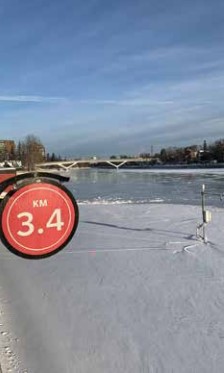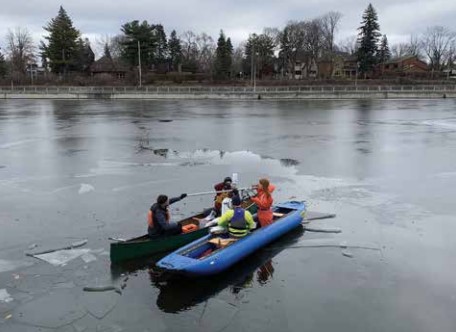John Dance
As is painfully obvious to all, and as a result of climate change, the Rideau Skateway has increasingly shorter seasons with later openings, but Carleton University engineering professors and students are exploring new techniques to open the Skateway earlier.
National Capital Commission (NCC) records show that in the 1970s and 1980s, the Skateway often opened before New Year’s Day. Now it’s rare if the opening is before mid-January, and this year it won’t open until February, if at all.
This grim scenario prompted the NCC to form a partnership with Carleton University to better understand why ice wasn’t forming and what would be needed to promote the early formation of ice strong enough to support the vehicles required to maintain the Skateway.
A key part of the project is gathering better weather data and analyzing it to understand how it relates to ice formation. To that end, last December, the Carleton team installed a specially built weather station in the Rideau Canal just across from the end of Mutchmor Road.

The special weather station for the ice research is located just across the Canal from the end of Mutchmor Road and is at the 3.4KM marker of the Skateway. Photo by Shawn Kenny
The station makes standard measurements like air temperature, wind speed, humidity, and precipitation but, in order to fully understand what may influence ice formation and retention, it also measures the temperature of a “column” of the water under the ice and the temperature at the “mudline.” In addition, the amount and intensity of solar radiation are recorded.
In order to open the Canal, the ice must be at least 30 centimetres thick so that vehicles and masses of skaters can be safely supported. This season there have not been 10 consecutive days of cold weather which is necessary to achieve the required ice thickness. Instead, there has been lots of temperature fluctuation and lots of snow.
Snow cover greatly impedes ice formation and that’s why the NCC has a small army of snow blowers and also uses high-volume pumps that effectively turn large snowfalls into slush which then builds up the thickness of the ice. The downside of the slush-to-ice approach is that the resulting ice is half as strong as ice that has formed without snow.
In December, the Carleton team, led by Professor Shawn Kenny of the Faculty of Engineering and Design, tested what’s dubbed a “snow cannon” which is really a conventional snow-making machine like those found at ski hills. The large piece of equipment was positioned to the side of the Canal and blew snow crystals into the water near the National Arts Centre. The crystals indeed had the effect of accelerating the growth of ice cover and the resulting ice endured through the subsequent warm weather.
The researchers are now modifying the equipment so that it will be even more effective. Challenges to this technique are that the equipment requires an electricity source and water supply, so the technique could only be employed at certain parts of the Skateway.
A second approach that is being investigated is designing a snow blower that is lighter than standard models and, more significantly, can be operated remotely, without a person behind it. By operating the snow blower remotely, snow removal can begin earlier which, in turn, results in earlier ice formation.

Pictured here conducting Canal ice studies are Dr. Derek Mueller (front orange vest) and Dr. Murray Richardson (front yellow jacket) – both professors from Carleton University’s Department of Geography and Environmental Studies (DGES) – along with Adam Garbo, a DGES researcher and Anneka Petersen (orange suit), an undergrad student in the Civil & Environmental Engineering Department at Carleton. Photo by Shawn Kenny
Other ideas will also be pursued, including the use of “thermosyphons.” According to the NCC blog on the project, “A thermosyphon is a passive heat exchange system. This technology allows cold air to get beneath the foundation of a structure (like a building or a road embankment) and redistributes heat into the air, above the surface. If applied to the Skateway, this technology would promote ice growth by cooling the water beneath the ice.”
“Tackling climate change on the Rideau Canal Skateway” is a four-year project. The NCC’s blog says, “We’re excited to see what the future holds for this iconic destination.






